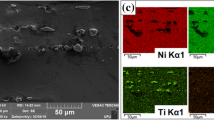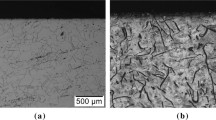Abstract
The residual stress and surface roughness enhancement of ground surfaces can decrease the lifetime of workpiece by reducing its fatigue life. It is critical to accurately predict and minimize the residual stress and surface toughness of ground surfaces in order to enhance efficiency of part production using grinding operations. A virtual machining system is developed in the research work to minimize the surface integrity and residual stress during grinding operations of Inconel 718. The cutting temperature during grinding operations is calculated using the Inconel alloy Johnson–Cook law models. Then, using the finite element method, residual stress during the grinding operation is estimated. Utilizing the established virtual machining method, the surface roughness is predicted in the study. Using the Taguchi optimization approach, the grinding parameters of depth of cut and feed velocity are optimized in order to reduce surface roughness as well as residual stress throughout grinding operations on Inconel 718 superalloy. To confirm the effectiveness of the developed technique in the study, simulation and experimentation are conducted. As a result, the quality as well as reliability of the ground surfaces can be enhanced by using the developed virtual machining system in the study to minimize the surface roughness and residual stress of produced parts using grinding operations.








Similar content being viewed by others
Change history
10 July 2024
This article has been retracted. Please see the Retraction Notice for more detail: https://doi.org/10.1007/s11665-024-09804-w
References
R. Spina and B. Cavalcante, Evaluation of Grinding of Unfilled and Glass Fiber Reinforced Polyamide 6, 6, Polymers, 2020, 12(10), p 2288.
Z. Chen, L. Qian, R. Cui, J. Liu, and Q. Zhang, Machining-Induced Residual Stress Analysis and Multi-objective Optimization for Milling Process of Mg-Li Alloy, Measurement, 2022, 204, p 112127.
C. Shan, M. Zhang, S. Zhang, and J. Dang, Prediction of Machining-Induced Residual Stress in Orthogonal Cutting of Ti6Al4V, Int. J. Adv. Manuf. Technol., 2020, 107(5), p 2375–2385.
M. Kumar, H.N. Singh Yadav, A. Kumar, and M. Das, An Overview of Magnetorheological Polishing Fluid Applied in Nano-finishing of Components, J. Micromanuf.., 2021, 5, p 25165984211008172.
A. Aggarwal and A.K. Singh, Development of Grinding Wheel Type Magnetorheological Finishing Process for Blind Hole Surfaces, Mater. Manuf. Processes, 2021, 36(4), p 457–478.
D. Curtis, H. Krain, A. Winder, and D. Novovic, Impact of Grinding Wheel Specification on Surface Integrity and Residual Stress When Grinding Inconel 718, Proc. Inst. Mech. Eng. Part B J. Eng. Manuf., 2021, 235(10), p 1668–1681.
F. Lavecchia, G. Percoco, E. Pei, and L.M. Galantucci, Computer Numerical Controlled Grinding and Physical Vapor Deposition for Fused Deposition Modelled Workpieces, Adv. Mater. Sci. Eng., 2018, 2018, p 1–7.
S. Malkin, Grinding Technology: Theory and Applications of Machining with Abrasives, Ellis Horwood Limited, Chichester, 1989.
S.K. Khare and S. Agarwal, Predictive Modeling of Surface Roughness in Grinding, Procedia CIRP, 2015, 31, p 375–380.
Z. Ding, G. Sun, M. Guo, X. Jiang, B. Li, and S.Y. Liang, Effect of Phase Transition on Micro-grinding-induced Residual Stress, J. Mater. Process. Technol., 2020, 281, p 116647.
G. **ao, B. Chen, S. Li, and X. Zhuo, Fatigue Life Analysis of Aero-Engine Blades for Abrasive Belt Grinding Considering Residual Stress, Eng. Fail. Anal., 2022, 131, p 105846.
S. Shen, B. Li, and W. Guo, Experimental Study on Grinding-Induced Residual Stress in C-250 Maraging Steel, Int. J. Adv. Manuf. Technol., 2020, 106(3), p 953–967.
Y. Wang, X. Chu, Y. Huang, G. Su, and D. Liu, Surface Residual Stress Distribution for Face Gear under Grinding with a Long-Radius Disk Wheel, Int. J. Mech. Sci., 2019, 159, p 260–266.
Y. He, G. **ao, W. Li, and Y. Huang, Residual Stress of a TC17 Titanium Alloy after Belt Grinding and Its Impact on the Fatigue Life, Materials, 2018, 11(11), p 2218.
J. Chen, Q. Fang, and L. Zhang, Investigate on Distribution and Scatter of Surface Residual Stress in Ultra-High Speed Grinding, Int. J. Adv. Manuf. Technol., 2014, 75(1), p 615–627.
W. Pei-Zhuo, H. Zhan-Shu, Z. Yuan-xi, and Z. Shu-Sen, Control of Grinding Surface Residual Stress of Inconel 718, Procedia Eng., 2017, 174, p 504–511.
H. Singh, V.S. Sharma, and M. Dogra, Exploration of Graphene Assisted Vegetables Oil Based Minimum Quantity Lubrication for Surface Grinding of TI-6AL-4V-ELI, Tribol. Int., 2020, 144, p 106113.
H. Singh, V.S. Sharma, S. Singh, and M. Dogra, Nanofluids Assisted Environmental Friendly Lubricating Strategies for the Surface Grinding of Titanium Alloy: Ti6Al4V-ELI, J. Manuf. Process., 2019, 39, p 241–249.
L. Ma, Y. Gong, and X. Chen, Study on Surface Roughness Model and Surface Forming Mechanism of Ceramics in Quick Point Grinding, Int. J. Mach. Tools Manuf., 2014, 77, p 82–92.
F. Kara, U. Köklü, and U. Kabasakaloğlu, Taguchi Optimization of Surface Roughness in Grinding of Cryogenically Treated AISI 5140 Steel, Mater. Test., 2020, 62(10), p 1041–1047.
Y. Liu, S. Song, Y. Zhang, W. Li, and G. **ao, Prediction of Surface Roughness of Abrasive Belt Grinding of Superalloy Material Based on RLSOM-RBF, Materials, 2021, 14(19), p 5701.
S. You, J. Tang, W. Zhou, W. Zhou, J. Zhao, and H. Chen, Research on Calculation of Contact Fatigue Life of Rough Tooth Surface Considering Residual Stress, Eng. Fail. Anal., 2022, 140, p 106459.
S. Agarwal and P.V. Rao, Modeling and Prediction of Surface Roughness in Ceramic Grinding, Int. J. Mach. Tools Manuf., 2010, 50(12), p 1065–1076.
X. Lei, D. **ang, P. Peng, X. Niu, B. Zhao, and G. Gao, Study on Surface Residual Stress of Hardened 12Cr2Ni4A Alloy Steel by Ultrasonic Vibration-Assisted ELID Grinding, Int. J. Adv. Manuf. Technol., 2022, 118(1), p 641–649.
N. Kumar Maroju and X. **, Effects of Vibration Assistance on Surface Residual Stress in Grinding of Ti6Al4V Alloy, Procedia Manuf., 2017, 10, p 171–82.
D. Nguyen, S. Yin, Q. Tang, and P.X. Son, Online Monitoring of Surface Roughness and Grinding Wheel Wear When Grinding Ti-6Al-4V Titanium Alloy using ANFIS-GPR Hybrid Algorithm and Taguchi Analysis, Precis. Eng., 2019, 55, p 275–292.
X. Ming, Q. Gao, H. Yan, J. Liu, and C. Liao, Mathematical Modeling and Machining Parameter Optimization for the Surface Roughness of Face Gear Grinding, Int. J. Adv. Manuf. Technol., 2017, 90(9), p 2453–2460.
Y. Li, Y. Liu, Y. Tian, Y. Wang, and J. Wang, Application of Improved Fireworks Algorithm in Grinding Surface Roughness Online Monitoring, J. Manuf. Process., 2022, 74, p 400–412.
M. Soori, B. Arezoo, and M. Habibi, Accuracy Analysis of Tool Deflection Error Modelling in Prediction of Milled Surfaces by a Virtual Machining System, Int. J. Comput. Appl. Technol., 2017, 55(4), p 308–321.
M. Soori, B. Arezoo, and M. Habibi, Virtual Machining Considering Dimensional, Geometrical and Tool Deflection Errors in Three-Axis CNC Milling Machines, J. Manuf. Syst., 2014, 33(4), p 498–507.
M. Soori, B. Arezoo, and M. Habibi, Dimensional and Geometrical Errors of Three-Axis CNC Milling Machines in a Virtual Machining System, Comput. Aided Des., 2013, 45(11), p 1306–1313.
M. Soori, B. Arezoo, and M. Habibi, Tool Deflection Error of Three-Axis Computer Numerical Control Milling Machines, Monitoring and Minimizing by a Virtual Machining System, J. Manuf. Sci. Eng., 2016 https://doi.org/10.1115/1.4032393
M. Soori and M. Asmael, Virtual Minimization of Residual Stress and Deflection Error in Five-Axis Milling of Turbine Blades, Stroj. Vestn. J. Mech. Eng., 2021, 67(5), p 235–244.
M. Soori and M. Asmael, Cutting Temperatures in Milling Operations of Difficult-to-Cut Materials, J. New Technol. Mater., 2021, 11(1), p 47–56.
M. Soori and B. Arezoo, A Review in Machining-Induced Residual Stress, J. New Technol. Mater., 2022, 12(1), p 64–83.
M. Soori, M. Asmael, A. Khan, and N. Farouk, Minimization of Surface Roughness in 5-axis Milling of Turbine Blades, Mech. Based Des. Struct. Mach., 2021 https://doi.org/10.1080/15397734.2021.1992779
M. Soori and M. Asamel, Mechanical Behavior of Materials in Metal Cutting Operations, A Review, J. New Technol. Mater., 2020, 10(2), p 79.
M. Soori, M. Asamel, and D. Solyali, Recent Development in Friction Stir Welding Process: A Review, SAE Int. J. Mater. Manuf., 2020, 14(1), p 18.
M. Soori and M. Asmael, Classification of Research and Applications of the Computer Aided Process Planning in Manufacturing Systems, Indep. J. Manag. Prod., 2021, 12(5), p 1250–1281.
M. Soori and M. Asmael, A Review of the Recent Development in Machining Parameter Optimization, Jordan J. Mech. Ind. Eng., 2022, 16(2), p 205–223.
M. Soori and B. Arezoo, Virtual Machining Systems for CNC Milling and Turning Machine Tools: A Review, Int. J. Eng. Future Technol., 2020, 18(1), p 56–104.
M. Soori and M. Asmael, Minimization of Deflection Error in Five Axis Milling of Impeller Blades, Facta Univ. Ser. Mech. Eng., 2021 https://doi.org/10.22190/FUME210822069S
R. Dastres, M. Soori, and M. Asmael, Radio Frequency Identification (RFID) Based Wireless Manufacturing Systems, A Review, Indep. J. Manag. Prod., 2022, 13(1), p 258–290.
X. Chen, W. Rowe, and D. McCormack, Analysis of the Transitional Temperature for Tensile Residual Stress in Grinding, J. Mater. Process. Technol., 2000, 107(1–3), p 216–221.
M. Balart, A. Bouzina, L. Edwards, and M. Fitzpatrick, The Onset of Tensile Residual Stresses in Grinding of Hardened Steels, Mater. Sci. Eng., A, 2004, 367(1–2), p 132–142.
J.C. Jaeger, Moving Sources of Heat and the Temperature of Sliding Contacts, Proc. R. Soc. N. S. W., 1942, 76, p 203–224.
O. Fergani, Y. Shao, I. Lazoglu, and S.Y. Liang, Temperature Effects on Grinding Residual Stress, Procedia CIRP, 2014, 14, p 2–6.
S. Timoshenko and J. Goodier, Theory of Elasticity, International Student Edition, Kogakusha Co Ltd., 1970, p 444
D. Ulutan, B.E. Alaca, and I. Lazoglu, Analytical Modelling of Residual Stresses in Machining, J. Mater. Process. Technol., 2007, 183(1), p 77–87.
C. Ji, Y. Li, X. Qin, Q. Zhao, D. Sun, and Y. **, 3D FEM Simulation of Helical Milling Hole Process for Titanium Alloy Ti-6Al-4V, Int. J. Adv. Manuf. Technol., 2015, 81(9), p 1733–1742.
A. He, G. **e, H. Zhang, and X. Wang, A Comparative Study on Johnson–Cook, Modified Johnson–Cook and Arrhenius-Type Constitutive Models to Predict the High Temperature Flow Stress in 20CrMo Alloy Steel, Mater. Des. (1980-2015), 2013, 52, p 677–85.
Y. Lin and X.-M. Chen, A Combined Johnson–Cook and Zerilli–Armstrong Model for Hot Compressed Typical High-Strength Alloy Steel, Comput. Mater. Sci., 2010, 49(3), p 628–633.
X. Wang, C. Huang, B. Zou, H. Liu, H. Zhu, and J. Wang, Dynamic Behavior and a Modified Johnson–Cook Constitutive Model of Inconel 718 at High Strain Rate and Elevated Temperature, Mater. Sci. Eng., A, 2013, 580, p 385–390.
F. Pashmforoush and R.D. Bagherinia, Influence of Water-Based Copper Nanofluid on Wheel Loading and Surface Roughness During Grinding of Inconel 738 Superalloy, J. Clean. Prod., 2018, 178, p 363–372.
T.R. Bement, Taguchi Techniques for Quality Engineering, Taylor & Francis, 1989.
W.G. Feather, H. Lim, and M. Knezevic, A Numerical Study into Element Type and Mesh Resolution for Crystal Plasticity Finite Element Modeling of Explicit Grain Structures, Comput. Mech., 2021, 67(1), p 33–55.
Author information
Authors and Affiliations
Corresponding author
Additional information
Publisher's Note
Springer Nature remains neutral with regard to jurisdictional claims in published maps and institutional affiliations.
This article has been retracted. Please see the retraction notice for more detail: https://doi.org/10.1007/s11665-024-09804-w"
Rights and permissions
Springer Nature or its licensor (e.g. a society or other partner) holds exclusive rights to this article under a publishing agreement with the author(s) or other rightsholder(s); author self-archiving of the accepted manuscript version of this article is solely governed by the terms of such publishing agreement and applicable law.
About this article
Cite this article
Soori, M., Arezoo, B. RETRACTED ARTICLE: Minimization of Surface Roughness and Residual Stress in Grinding Operations of Inconel 718. J. of Materi Eng and Perform 32, 8185–8194 (2023). https://doi.org/10.1007/s11665-022-07721-4
Received:
Revised:
Accepted:
Published:
Issue Date:
DOI: https://doi.org/10.1007/s11665-022-07721-4




